Pan-Arctic Climate and Land Cover Trends Derived from Multi-Variate and Multi-Scale Analyses (1981–2012)
Abstract
:1. Introduction
2. Data and Methods
2.1. Maximum Snow Water Equivalent—ESA DUE GlobSnow
2.2. Temperature and Precipitation—Climate Research Unit (CRU)
2.3. NDVI3g—GIMMS
2.4. Arctic Biodiversity Assessment—CAFF
2.5. Trend Analysis
2.6. Vegetation Structure Change Detection Using High Resolution Remote Sensing Data
3. Results and Discussion
3.1. Pan-Arctic Trends on Monthly Scale
3.2. Monthly Inter-Annual Trend Dynamics for Different Arctic Regions
3.3. High-Resolution Change Mapping of the Taiga-Tundra Transition Zone in Northern Siberia
4. Conclusion
Supplementary Information
remotesensing-06-02296-s001.pdfAcknowledgments
Author Contribution
Conflicts of Interest
References and Notes
- Moritz, R.E.; Bitz, C.M.; Steig, E.J. Dynamics of recent climate change in the Arctic. Science 2002, 297, 1497–1502. [Google Scholar]
- Grace, J.; Beringer, F.; Laszlo, N. Impacts of climate change on the tree line. Ann. Bot 2002, 90, 537–544. [Google Scholar]
- Nelson, F.E. (Un)frozen in Time. Science 2003, 69, 8–10. [Google Scholar]
- Miller, G.H.; Brigham-Grette, J.; Alley, R.B.; Anderson, L.; Bauch, H.A.; Douglas, M.S.V.; Edwards, M.E.; Elias, S.A.; Finney, B.P.; Fitzpatrick, J.J.; et al. Temperature and precipitation history of the Arctic. Quat. Sci. Rev 2010, 29, 1679–1715. [Google Scholar]
- Kaplan, J.O.; New, M. Arctic climate change with a 2 °C global warming: Timing, climate patterns and vegetation change. Clim. Chang 2006, 79, 213–241. [Google Scholar]
- Post, E.; Christensen, T.R.; Elberling, B.; Fox, A.D.; Gilg, O.; Forchhammer, M.C.; Bret-Harte, M.S.; Callaghan, T.V.; Hik, D.S.; Høye, T.T.; et al. Ecological dynamics across the Arctic associated with recent climate change. Science 2009, 325, 1355–1358. [Google Scholar]
- Stow, D.A.; Hope, A.; McGuire, D.; Verbyla, D.; Gamon, J.; Huemmrich, F.; Houston, S.; Racine, C.; Sturm, M.; Tape, K.; et al. Remote sensing of vegetation and land-cover change in Arctic Tundra Ecosystems. Remote Sens. Environ 2004, 89, 281–308. [Google Scholar]
- Myneni, R.B.; Keeling, C.D.; Tucker, C.J.; Asrar, G.; Nemani, R.R. Increased plant growth in the northern high latitudes from 1981 to 1991. Nature 1997, 386, 698–702. [Google Scholar]
- Romanovsky, V.; Burgess, M.; Smith, S.; Yoshikawa, K.; Brown, J. Permafrost temperature records: Indicators of climate change. EOS Trans. AGU 2002, 83, 589–594. [Google Scholar]
- Serreze, M.C.; Walsh, J.E.; Osterkamp, T.E.; Dyurgerov, M.; Romanovsky, V.E.; Oechel, W.C.; Morison, J.; Zhang, T.; Barry, R.G. Observational evidence of recent change in the northern high-latitude environment. Clim. Chang 2000, 46, 159–207. [Google Scholar]
- Overpeck, J.; Hughen, K.; Hardy, D.; Bradley, R.; Case, R.; Douglas, M.; Finney, B.; Gajewski, K.; Jacoby, G.; Jennings, A.; et al. Arctic environmental change of the last four centuries. Science 1997, 278, 1251–1256. [Google Scholar]
- Crowley, T.J. Causes of climate change over the past 1000 years. Science 2000, 289, 270–277. [Google Scholar]
- Chapin, F.S., III; Sturm, M.; Serreze, M.C.; McFadden, J.P.; Key, J.R.; Lloyd, A.H.; McGuire, A.D.; Rupp, T.S.; Lynch, A.H.; Schimel, J.P.; et al. Role of land-surface changes in arctic summer warming. Science 2005, 310, 657–660. [Google Scholar]
- Loranty, M.M.; Goetz, S.J.; Beck, P.S.A. Tundra vegetation effects on pan-Arctic albedo. Environ. Res. Lett 2011, 6, 1–7. [Google Scholar]
- Blok, D.; Sass-Klaassen, U.; Schaepman-Strub, G.; Heijmans, M.M.P.D.; Sauren, P.; Berendse, F. What are the main climate drivers for shrub growth in Northeastern Siberian tundra? Biogeosciences 2011, 8, 1169–1179. [Google Scholar]
- Xu, L.; Myneni, R.B.; Chapin, F.S., III; Callaghan, T.V.; Pinzon, J.E.; Tucker, C.J.; Zhu, Z.; Bi, J.; Ciais, P.; Tømmervik, H.; et al. Temperature and vegetation seasonality diminishment over northern lands. Nat. Clim. Chang 2013, 3, 581–586. [Google Scholar]
- Beringer, J.; Tapper, N.J.; Mchugh, I.; Chapin, F.S., III; Lynch, A.H.; Serreze, M.C.; Slater, A. Impact of Arctic treeline on synoptic climate. Geophys. Res. Lett 2001, 28, 4247–4250. [Google Scholar]
- Lawrence, D.M.; Slater, A.G.; Tomas, R.A.; Holland, M.M.; Deser, C. Accelerated Arctic land warming and permafrost degradation during rapid sea ice loss. Geophys. Res. Lett 2008, 35, 1–6. [Google Scholar]
- Bhatt, U.S.; Walker, D.A.; Raynolds, M.K.; Bieniek, P.A.; Epstein, H.E.; Comiso, J.C.; Pinzon, J.E.; Tucker, C.J; Polyakov, I.V. Recent declines in warming and vegetation greening trends over Pan-Arctic Tundra. Remote Sens 2013, 5, 4229–4254. [Google Scholar]
- Bokhorst, S.; Bjerke, J.W.; Bowles, F.W.; Melillo, J.; Callaghan, T.V.; Phoenix, G.K. Impacts of extreme winter warming in the sub-Arctic: Growing season responses of dwarf shrub heathland. Glob. Chang. Biol 2008, 14, 2603–2612. [Google Scholar]
- Myers-Smith, I.H.; Forbes, B.C.; Wilmking, M.; Hallinger, M.; Lantz, T.; Blok, D.; Tape, K.D.; Macias-Fauria, M.; Sass-Klaassen, U.; Lévesque, E.; et al. Shrub expansion in tundra ecosystems: Dynamics, impacts and research priorities. Environ. Res. Lett 2011, 6, 1–15. [Google Scholar]
- Blok, D.; Heijmans, M.M.P.D.; Schaepman-Strub, G.; Kononov, A.V.; Maximov, T.C.; Berendse, F. Shrub expansion may reduce summer permafrost thaw in Siberian tundra. Glob. Chang. Biol 2010, 16, 1296–1305. [Google Scholar]
- Tape, K.; Sturm, M.; Racine, C. The evidence for shrub expansion in Northern Alaska and the Pan-Arctic. Glob. Chang. Biol 2006, 12, 686–702. [Google Scholar]
- Berner, L.T.; Beck, P.S.A; Bunn, A.G.; Goetz, S.J. Plant response to climate change along the forest-tundra ecotone in northeastern Siberia. Glob. Chang. Biol 2013, 19, 3449–3462. [Google Scholar]
- Epstein, H.E.; Beringer, J.; Gould, W.A.; Lloyd, A.H.; Thompson, C.D.; Chapin, F.S., III; Michaelson, G.J.; Ping, C.L.; Rupp, T.S.; Walker, D.A. The nature of spatial transitions in the Arctic. J. Biogeogr 2004, 31, 1917–1933. [Google Scholar]
- Sturm, M.; Racine, C.H.; Tape, K.D.; Cronin, T.W.; Caldwell, R.L.; Marshall, J. Increasing shrub abundance in the Arctic. Nature 2001, 411, 546–547. [Google Scholar]
- Bunn, A.G.; Goetz, S.J. Trends in satellite-observed circumpolar photosynthetic activity from 1982 to 2003: The influence of seasonality, cover type, and vegetation density. Earth Interact 2006, 10, 1–19. [Google Scholar]
- Ranson, K.J.; Sun, G.; Kharuk, V.I.; Kovacs, K. Assessing tundra–taiga boundary with multi-sensor satellite data. Remote Sens. Environ 2004, 93, 283–295. [Google Scholar]
- Shiyatov, S.G. Rates of change in the upper treeline ecotone in the Polar Ural Mountains. Pages News 2003, 11, 8–10. [Google Scholar]
- Harsch, M.A.; Hulme, P.P.; McGlone, M.S.; Duncan, R.P. Are treelines advancing? A global meta-analysis of treeline response to climate warming. Ecol. Lett 2009, 12, 1040–1049. [Google Scholar]
- Olthof, I.; Pouliot, D. Treeline vegetation composition and change in Canada’s western Subarctic from AVHRR and canopy reflectance modeling. Remote Sens. Environ 2010, 114, 805–815. [Google Scholar]
- Sun, G.; Ranson, K.; Kharuk, V. Characterization and Monitoring of Tundra-Taiga Transition Zone with Multi-Sensor Satellite Data. In Eurasian Arctic Land Cover and Land Use in a Changing Climate; Gutman, G., Reissell, A., Eds.; Springer: Dordrecht, The Netherlands, 2011; pp. 53–77. [Google Scholar]
- Kharuk, V.I.; Ranson, K.J.; Im, S.T.; Naurzbaev, M.M. Forest-tundra larch forests and climatic trends. Russ. J. Ecol 2006, 37, 291–298. [Google Scholar]
- CAFF. Arctic Biodiversity Trends 2010 Selected Indicators of Change, 1st ed; Kurvits, T., Alfthan, B., Mork, E., Eds.; Conservation of Arctic Flora and Fauna: Akureyri, Iceland, 2010. [Google Scholar]
- Luojus, K.; Pulliainen, J.; Takala, M.; Lemmetyinen, J.; Kangwa, M.; Solberg, R.; Rott, H.; Derksen, C.; Wiesmann, A.; Metsämäki, S.; et al. Global Snow Monitoring for Climate Research Final Report, 2011. World Meteorological Organization. Available online: http://www.wmo.int/pages/prog/www/OSY/Meetings/GCW-IM1/Doc11.1_GlobSnow_Report.pdf (accessed on 1 March 2014).
- Pulliainen, J. Mapping of snow water equivalent and snow depth in boreal and sub-arctic zones by assimilating space-borne microwave radiometer data and ground-based observations. Remote Sens. Environ 2006, 101, 257–269. [Google Scholar]
- Takala, M.; Luojus, K.; Pulliainen, J.; Derksen, C.; Lemmetyinen, J.; Kärnä, J.-P.; Koskinen, J.; Bojkov, B. Estimating northern hemisphere snow water equivalent for climate research through assimilation of space-borne radiometer data and ground-based measurements. Remote Sens. Environ 2011, 115, 3517–3529. [Google Scholar]
- Hancock, S.; Baxter, R.; Evans, J.; Huntley, B. Evaluating global snow water equivalent products for testing land surface models. Remote Sens. Environ 2013, 128, 107–117. [Google Scholar]
- Jones, P.D.; Moberg, A. Hemispheric and large-scale surface air temperature variations: An extensive revision and an update to 2001. J. Clim 2003, 16, 206–223. [Google Scholar]
- New, M.; Hulme, M.; Jones, P. Representing twentieth-century space-time climate variability. Part II: Development of 1901–96 monthly grids of terrestrial surface climate. J. Clim 2000, 2217–2238. [Google Scholar]
- New, M.; Hulme, M.; Jones, P. Representing twentieth-century space-time climate variability. Part I: Development of a 1961–90 mean monthly terrestrial climatology. J. Clim 1999, 12, 829–856. [Google Scholar]
- Semenov, V.A.; Latif, M. The early twentieth century warming and winter Arctic sea ice. Cryosphere Discuss 2012, 6, 2037–2057. [Google Scholar]
- Brown, R.; Derksen, C.; Wang, L. A multi-data set analysis of variability and change in Arctic spring snow cover extent, 1967–2008. J. Geophys. Res 2010, 115, 1–16. [Google Scholar]
- Park, H.; Walsh, J.E.; Kim, Y.; Nakai, T.; Ohata, T. The role of declining Arctic sea ice in recent decreasing terrestrial Arctic snow depths. Polar Sci 2013, 7, 174–187. [Google Scholar]
- Rawlins, M.A.; Willmott, C.J.; Shiklomanov, A.; Linder, E.; Frolking, S.; Lammers, R.B.; Vörösmarty, C.J. Evaluation of trends in derived snowfall and rainfall across Eurasia and linkages with discharge to the Arctic Ocean. Geophys. Res. Lett 2006, 33, 1–4. [Google Scholar]
- Tucker, C.J.; Pinzon, J.E.; Brown, M.E.; Slayback, D.A.; Pak, E.W.; Mahoney, R.; Vermote, E.F.; El Saleous, N. An extended AVHRR 8-km NDVI dataset compatible with MODIS and SPOT vegetation NDVI data. Int. J. Remote Sens 2005, 26, 4485–4498. [Google Scholar]
- Slayback, D.A.; Pinzon, J.E.; Los, S.O.; Tucker, C.J. Northern hemisphere photosynthetic trends 1982–99. Glob. Chang. Biol 2003, 9, 1–15. [Google Scholar]
- Epstein, H.E.; Raynolds, M.K.; Walker, D.A.; Bhatt, U.S.; Tucker, C.J.; Pinzon, J.E. Dynamics of aboveground phytomass of the circumpolar Arctic tundra during the past three decades. Environ. Res. Lett 2012, 7, 1–12. [Google Scholar]
- Piao, S.; Wang, X.; Ciais, P.; Zhu, B.; Wang, T.; Liu, J. Changes in satellite-derived vegetation growth trend in temperate and boreal Eurasia from 1982 to 2006. Glob. Chang. Biol 2011, 17, 3228–3239. [Google Scholar]
- Macias-Fauria, M.; Forbes, B.C.; Zetterberg, P.; Kumplala, T. Eurasian Arctic greening reveals teleconnections and the potential for structurally novel ecosystems. Nat. Clim. Chang 2012, 2, 613–618. [Google Scholar]
- Wang, X.; Piao, S.; Ciais, P.; Li, J.; Friedlingstein, P.; Koven, C.; Chen, A. Spring temperature change and its implication in the change of vegetation growth in North America from 1982 to 2006. Proc. Natl. Acad. Sci. USA 2011, 108, 1240–1245. [Google Scholar]
- Urban, M.; Forkel, M.; Schmullius, C.; Hese, S.; Hüttich, C.; Herold, M. Identification of land surface temperature and albedo trends in AVHRR Pathfinder data from 1982 to 2005 for northern Siberia. Int. J. Remote Sens 2013, 34, 4491–4507. [Google Scholar]
- Zhu, Z.; Bi, J.; Pan, Y.; Ganguly, S.; Anav, A.; Xu, L.; Samanta, A.; Piao, S.; Nemani, R.R.; Myneni, R. Global data sets of Vegetation Leaf Area Index (LAI)3g and fraction of Photosynthetically Active Radiation (FPAR)3g derived from Global Inventory Modeling and Mapping Studies (GIMMS) Normalized Difference Vegetation Index (NDVI3g) for the period 1981 to 2011. Remote Sens 2013, 5, 927–948. [Google Scholar]
- Gleason, A.C.R.; Prince, S.D.; Goetz, S.J.; Small, J. Effects of orbital drift on land surface temperature measured by AVHRR thermal sensors. Remote Sens. Environ 2002, 79, 147–165. [Google Scholar]
- Julien, Y.; Sobrino, J.A. Correcting AVHRR long term data record V3 estimated LST from orbital drift effects. Remote Sens. Environ 2012, 123, 207–219. [Google Scholar]
- Pinzon, J.E. Revisiting error, precision and uncertainty in NDVI AVHRR data: development of a consistent NDVI3g time series. Remote Sens 2013. submitted. [Google Scholar]
- Holben, B.N. Characteristics of maximum-value composite images from temporal AVHRR data. Int. J. Remote Sens 1986, 7, 1417–1434. [Google Scholar]
- Walker, A.D.; Raynolds, M.K.; Daniels, F.J.A.; Einarsson, E.; Elvebakk, A.; Gould, W.A.; Katenin, A.E.; Kholod, S.S.; Markon, C.J.; Melnikov, E.S.; et al. The circumpolar Arctic vegetation map. J. Veg. Sci 2005, 16, 267–282. [Google Scholar]
- Talbot, S.; Meades, W. Circumboreal Vegetation Map (CBVM) Mapping the Green Halo—Concept Paper; CAFF International Secretariat: Akureyri, Iceland, 2011. [Google Scholar]
- Goetz, S.J.; Bunn, A.G.; Fiske, G.J.; Houghton, R.A. Satellite-observed photosynthetic trends across boreal North America associated with climate and fire disturbance. Proc. Natl. Acad. Sci. USA 2005, 102, 13521–13525. [Google Scholar]
- De Jong, R.; de Bruin, S.; de Wit, A.; Schaepman, M.E.; Dent, D.L. Analysis of monotonic greening and browning trends from global NDVI time-series. Remote Sens. Environ 2011, 115, 692–702. [Google Scholar]
- Forkel, M.; Carvalhais, N.; Verbesselt, J.; Mahecha, M.D.; Neigh, C.S.R.; Reichstein, M. Trend change detection in NDVI time series: Effects of inter-annual variability and methodology. Remote Sens 2013, 5, 2113–2144. [Google Scholar]
- Mann, H.B. Nonparametric tests against trend. Econometrica 1945, 13, 245–259. [Google Scholar]
- Jacoby, G.C.; Lovelius, N.V.; Shumilov, O.I.; Raspopov, O.M.; Karbainov, J.M.; Frank, D.C. Long-term temperature trends and tree growth in the Taymir Region of Northern Siberia. Quat. Res 2000, 53, 312–318. [Google Scholar]
- Shvidenko, A.Z.; Gustafson, E.; Mcguire, A.D.; Kharuk, V.I.; Schepaschenko, D.G.; Shugart, H.H.; Tchebakova, N.M.; Vygodskaya, N.N.; Onuchin, A.A.; Hayes, D.J.; et al. Terrestrial Ecosystems and Their Change. In Regional Environmental Changes in Siberia and Their Global Consequences; Groisman, P.Y., Gutman, G., Eds.; Springer Netherlands: Dordrecht, The Netherlands, 2013; pp. 171–249. [Google Scholar]
- Kharuk, V.I.; Dvinskaya, M.L.; Ranson, K.J.; Im, S.T. Expansion of evergreen conifers to the larch-dominated zone and climatic trends. Russ. J. Ecol 2005, 36, 164–170. [Google Scholar]
- MacDonald, G.M.; Kremenetski, K.V.; Beilman, D.W. Climate change and the northern Russian treeline zone. Philos. Trans. R. Soc. B 2008, 363, 2283–2299. [Google Scholar]
- Sidorova, O.V.; Siegwolf, R.T.W.; Saurer, M.; Naurzbaev, M.M.; Shashkin, A.V.; Vaganov, E.A. Spatial patterns of climatic changes in the Eurasian north reflected in Siberian larch tree-ring parameters and stable isotopes. Glob. Chang. Biol 2010, 16, 1003–1018. [Google Scholar]
- Landsat: MSS Scene; LM11590081973207AAA05; NASA Landsat Programm: Sioux Falls, SD, USA, 1973.
- Landsat: MSS Scene; LM11590091973207AAA05; NASA Landsat Programm: Sioux Falls, SD, USA, 1973.
- Richter, R. A spatially adaptive fast atmospheric correction algorithm. Int. J. Remote Sens 1996, 17, 1201–1214. [Google Scholar]
- Eastman, J.R.; Sangermano, F.; Machado, E.A.; Rogan, J.; Anyamba, A. Global trends in seasonality of normalized difference vegetation index (NDVI), 1982–2011. Remote Sens 2013, 5, 4799–4818. [Google Scholar]
- Liston, G.E.; Hiemstra, C.A. The changing cryosphere: Pan-Arctic snow trends (1979–2009). J. Clim 2011, 24, 5691–5712. [Google Scholar]
- Kattsov, V.M.; Källén, E.; Cattle, H.; Christensen, J.; Drange, H.; Hanssen-bauer, I.; Jóhannesen, T.; Karol, I.; Räisänen, J.; Svensson, G.; et al. Future Climate Change: Modeling and Scenarios for the Arctic. In Arctic Climate Impact Assessment—Scientific Report; Symon, C., Arris, L., Heal, B., Eds.; Cambridge University Press: Cambridge, UK, 2005. [Google Scholar]
- Peili, W.; Haak, H.; Wood, R.; Jungclaus, J.; Furevik, T. Simulating the Terms in the Arctic Hydrological Budget. In Arctic-Subarctic Ocean Fluxes: Defining the Role of the Northern Seas in Climate; Dickson, R., Meincke, J., Rhines, P., Eds.; Springer: Dordrecht, The Netherlands, 2008; pp. 363–384. [Google Scholar]
- Hüttich, C.; Herold, M.; Schmullius, C.; Egorov, V.; Bartalev, S.A. Indicators of Northern Eurasia’s land-cover change trends from SPOT-VEGETATION time-series analysis 1998–2005. Int. J. Remote Sens 2007, 28, 4199–4206. [Google Scholar]
- Delbart, N.; Picard, G.; Le Toan, T.; Kergoat, L.; Quegan, S.; Woodward, I.; Dye, D.; Fedotova, V. Spring phenology in boreal Eurasia over a nearly century time scale. Glob. Chang. Biol 2008, 14, 603–614. [Google Scholar]
- Räisänen, J. Warmer climate: Less or more snow? Clim. Dyn 2007, 30, 307–319. [Google Scholar]
- Martin, P.D.; Jenkins, J.L.; Adams, F.J.; Jorgenson, M.T.; Matz, A.C.; Payer, D.C.; Reynolds, P.E.; Tidwell, A.C.; Zelenak, J.R. Wildlife Response to Environmental Arctic Change: Predicting Future Habitats of Arctic Alaska, 2009. U.S. Fish and Wildlife Service; p. 138. Available online: http://www.fws.gov/alaska/pdf/wildreach_workshop_report.pdf (accessed on 7 March 2014).
- Callaghan, T.V.; Johansson, M.; Brown, R.D.; Groisman, P.Y.; Labba, N.; Radionov, V.; Barry, R.G.; Bulygina, O.N.; Essery, R.L.H.; Frolov, D.M.; et al. The Changing Face of Arctic Snow Cover: A Synthesis of Observed and Projected Changes. AMBIO 2011, 40, 17–31. [Google Scholar]
- Gagnon, A.S.; Gough, W.A. Hydro-climatic trends in the Hudson Bay Region, Canada. Can. Water Resour. J 2002, 27, 245–262. [Google Scholar]
- Walker, D.A.; Jia, G.J.; Epstein, H.E.; Raynolds, M.K.; Chapin, F.S., III; Copass, C.; Hinzman, L.D.; Knudson, J.; Maier, H.; Michaelson, G.J.; et al. Vegetation-soil-thaw-depth relationships along a low-arctic bioclimate gradient, Alaska: Synthesis of information from the ATLAS studies. Permafr. Periglac. Process 2003, 14, 103–123. [Google Scholar]
- Comiso, J.C.; Parkinson, C.L.; Gersten, R.; Stock, L. Accelerated decline in the Arctic sea ice cover. Geophys. Res. Lett 2008, 35, 1–6. [Google Scholar]
- Francis, J.A.; Vavrus, S.J. Evidence linking Arctic amplification to extreme weather in mid-latitudes. Geophys. Res. Lett 2012, 39, 1–6. [Google Scholar]
- Cohen, J.L.; Furtado, J.C.; Barlow, M.; Alexeev, V.; Cherry, J.E. Arctic warming, increasing snow cover and widespread boreal winter cooling. Environ. Res. Lett 2012, 7, 1–8. [Google Scholar]
- Bokhorst, S.F.; Bjerke, J.W.; Tømmervik, H.; Callaghan, T.V.; Phoenix, G.K. Winter warming events damage sub-Arctic vegetation: consistent evidence from an experimental manipulation and a natural event. J. Ecol 2009, 97, 1408–1415. [Google Scholar]
- Picard, G.; Quegan, S.; Delbart, N.; Lomas, M.R.; Le Toan, T.; Woodward, F.I. Bud-burst modelling in Siberia and its impact on quantifying the carbon budget. Glob. Chang. Biol 2005, 11, 2164–2176. [Google Scholar]
- Global Surface Summary of the Day: GSOD 2012; National Climatic Data Center: Asheville, NC, USA, 2012.
- Eberle, J.; Clausnitzer, S.; Hüttich, C.; Schmullius, C. Multi-source data processing middleware for land monitoring within a web-based spatial data infrastructure for Siberia. ISPRS Int. J. Geo-Inf 2013, 2, 553–576. [Google Scholar]
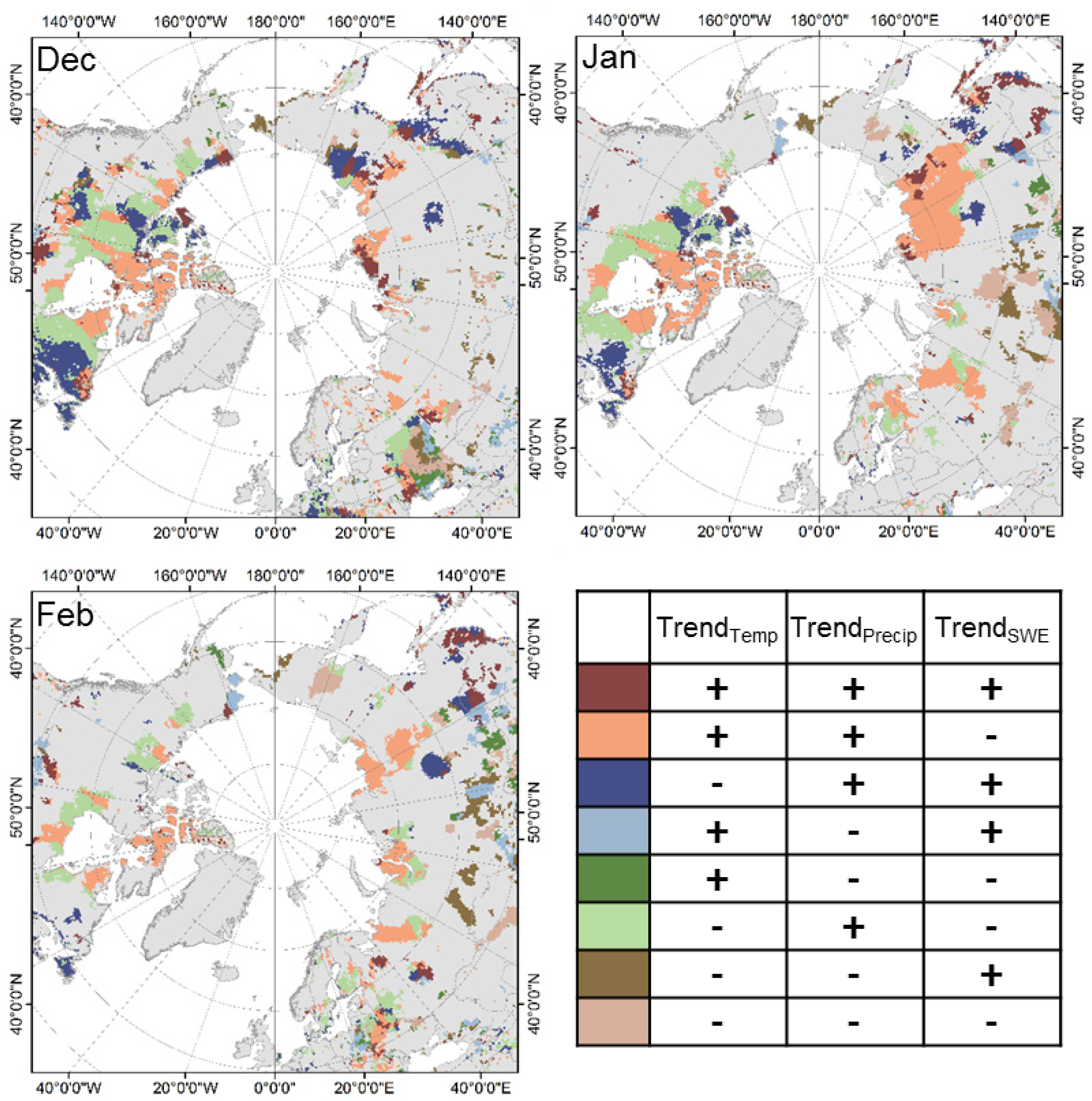
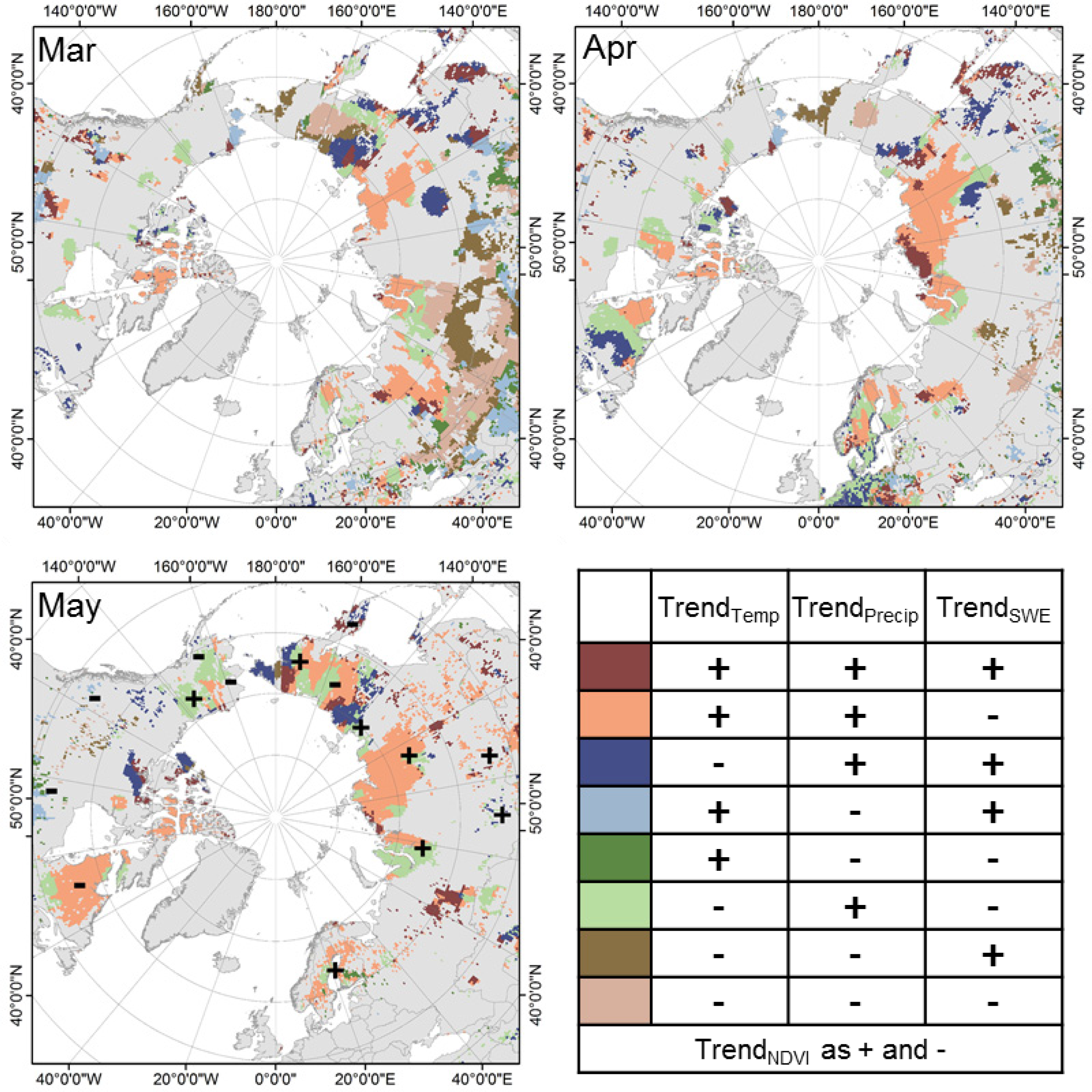
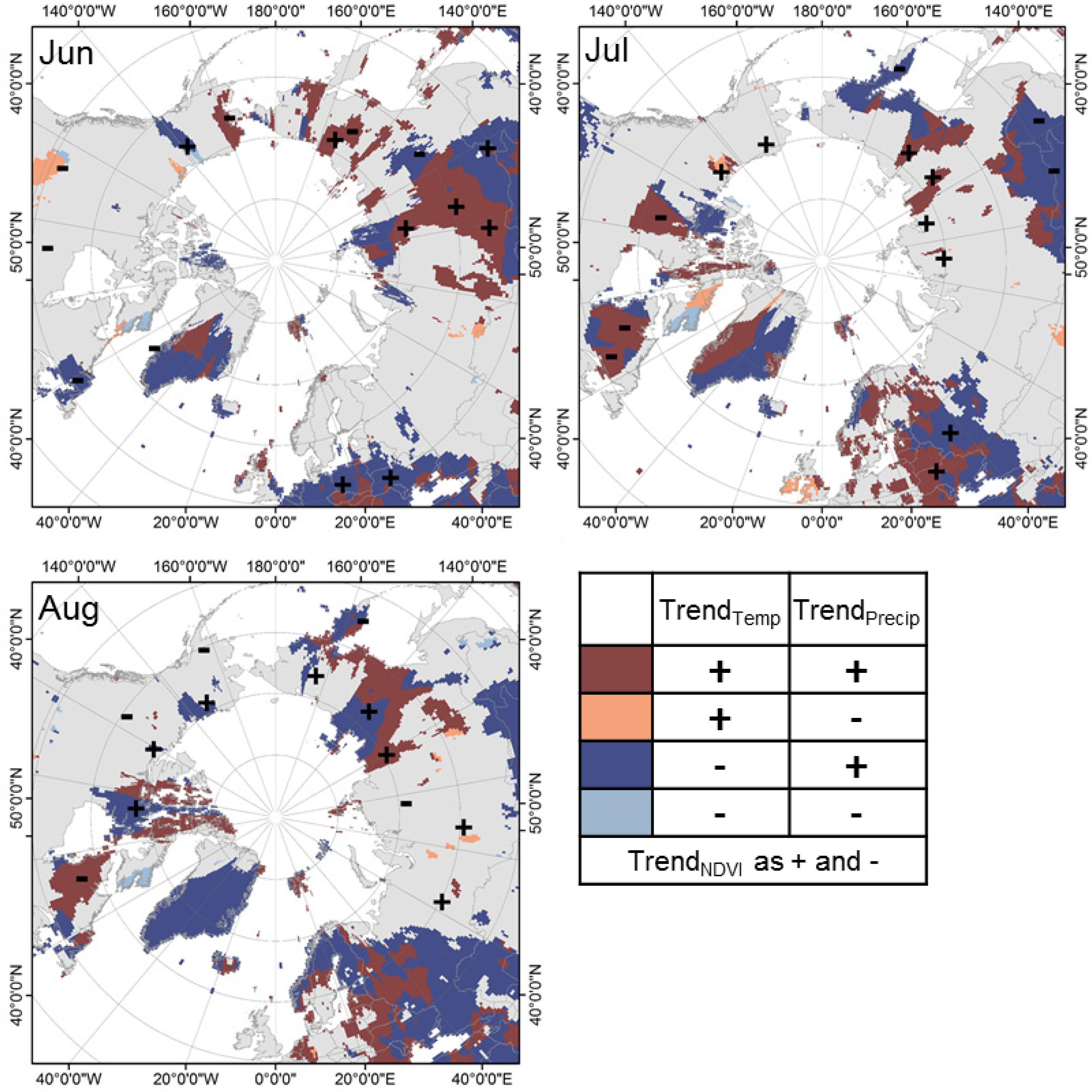
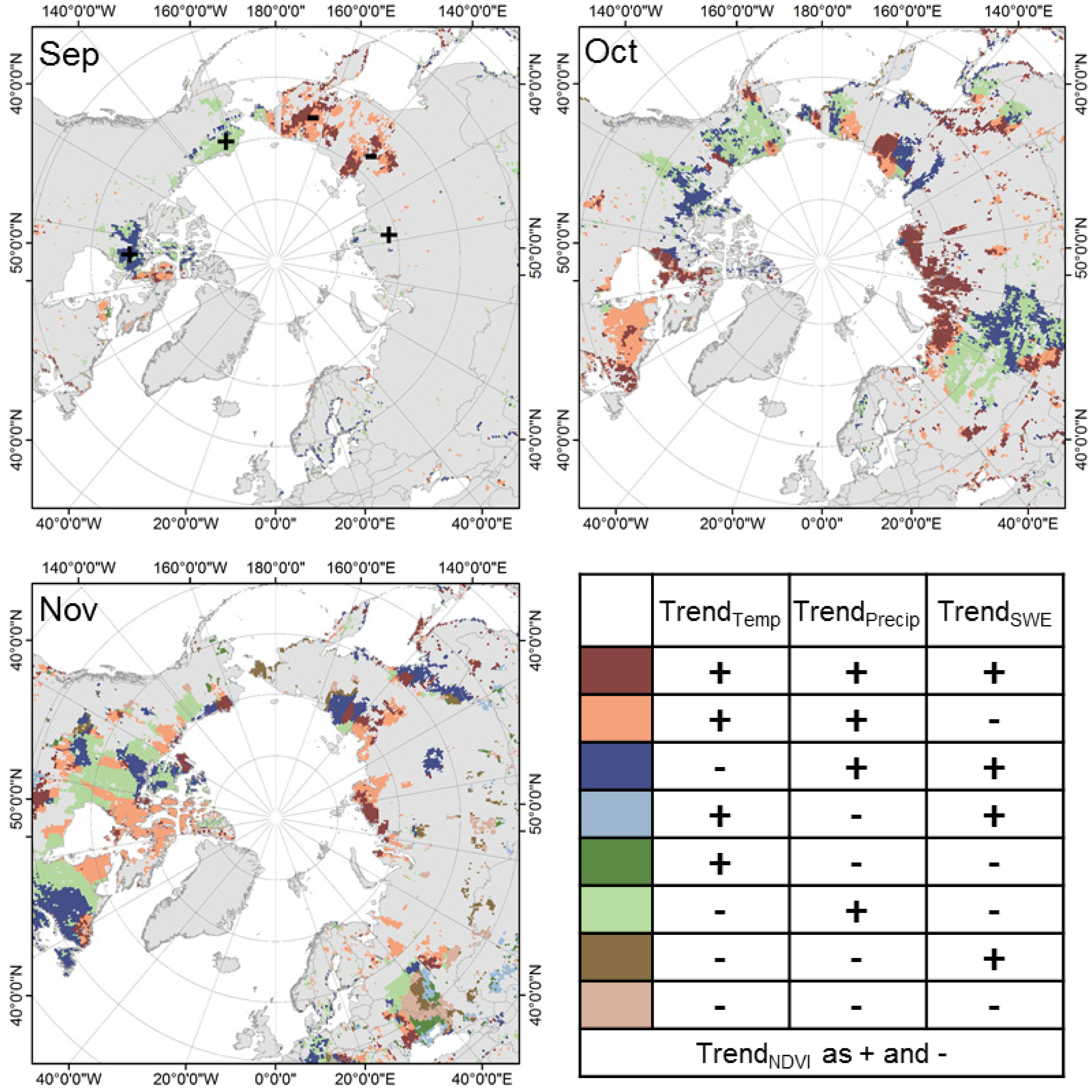
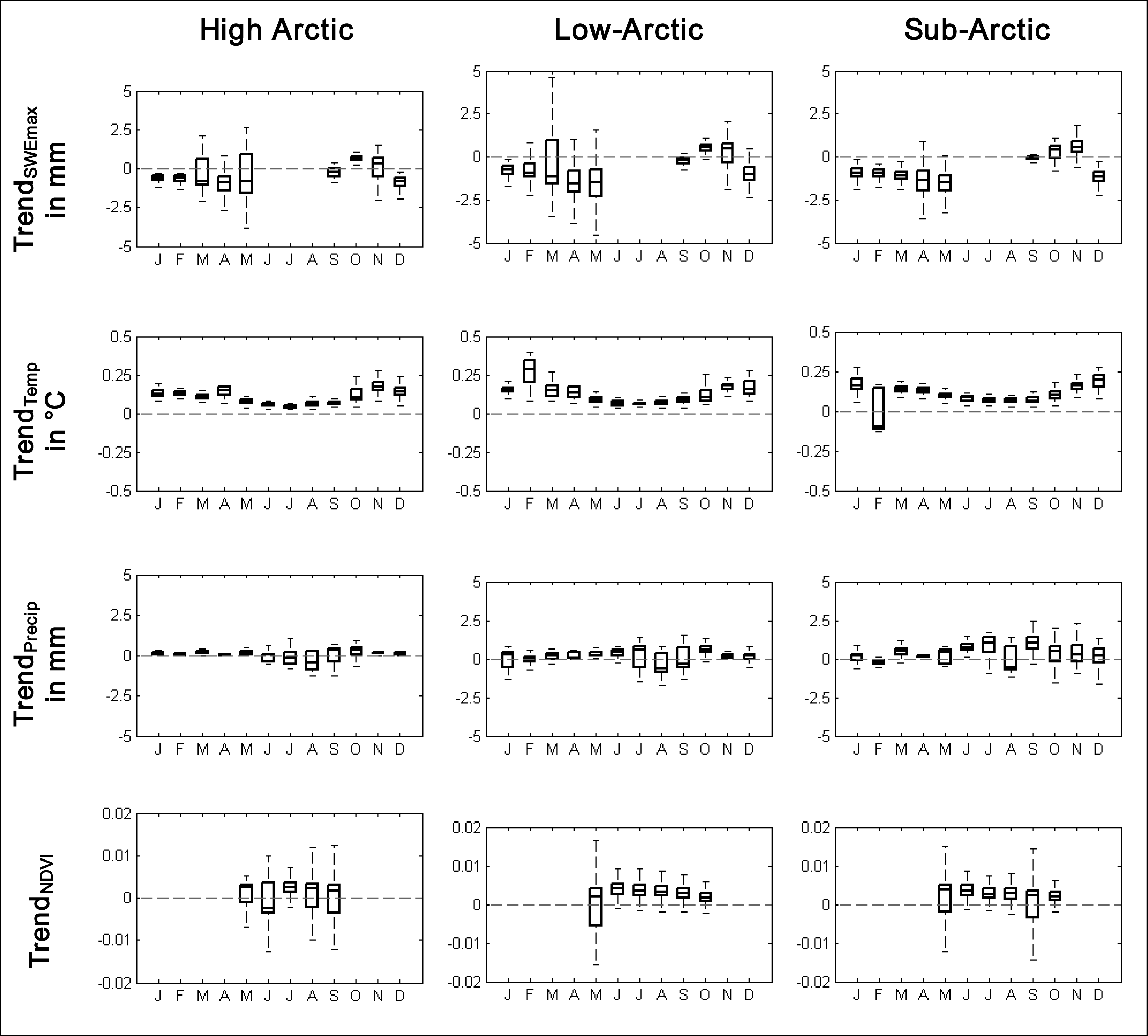
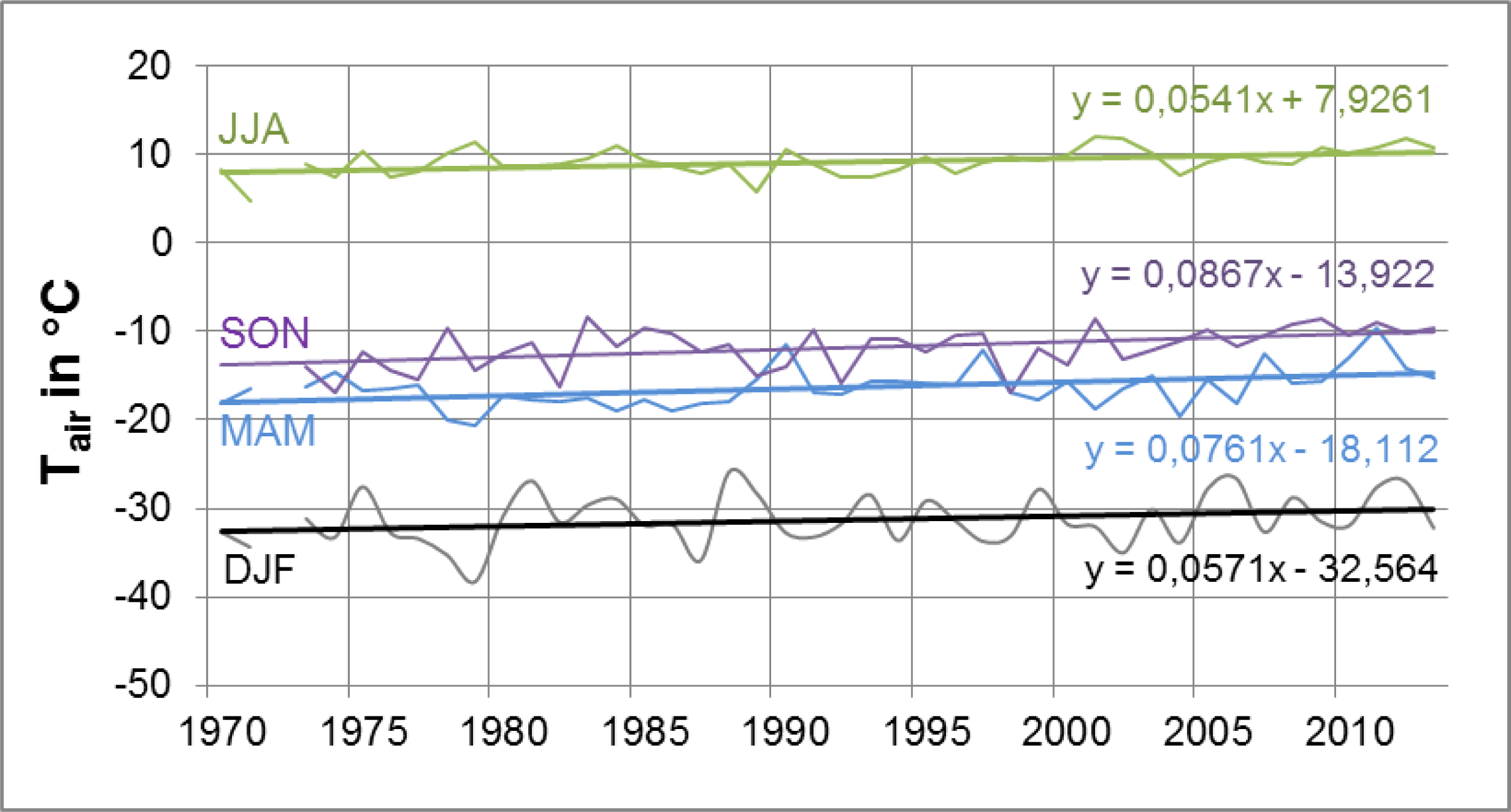
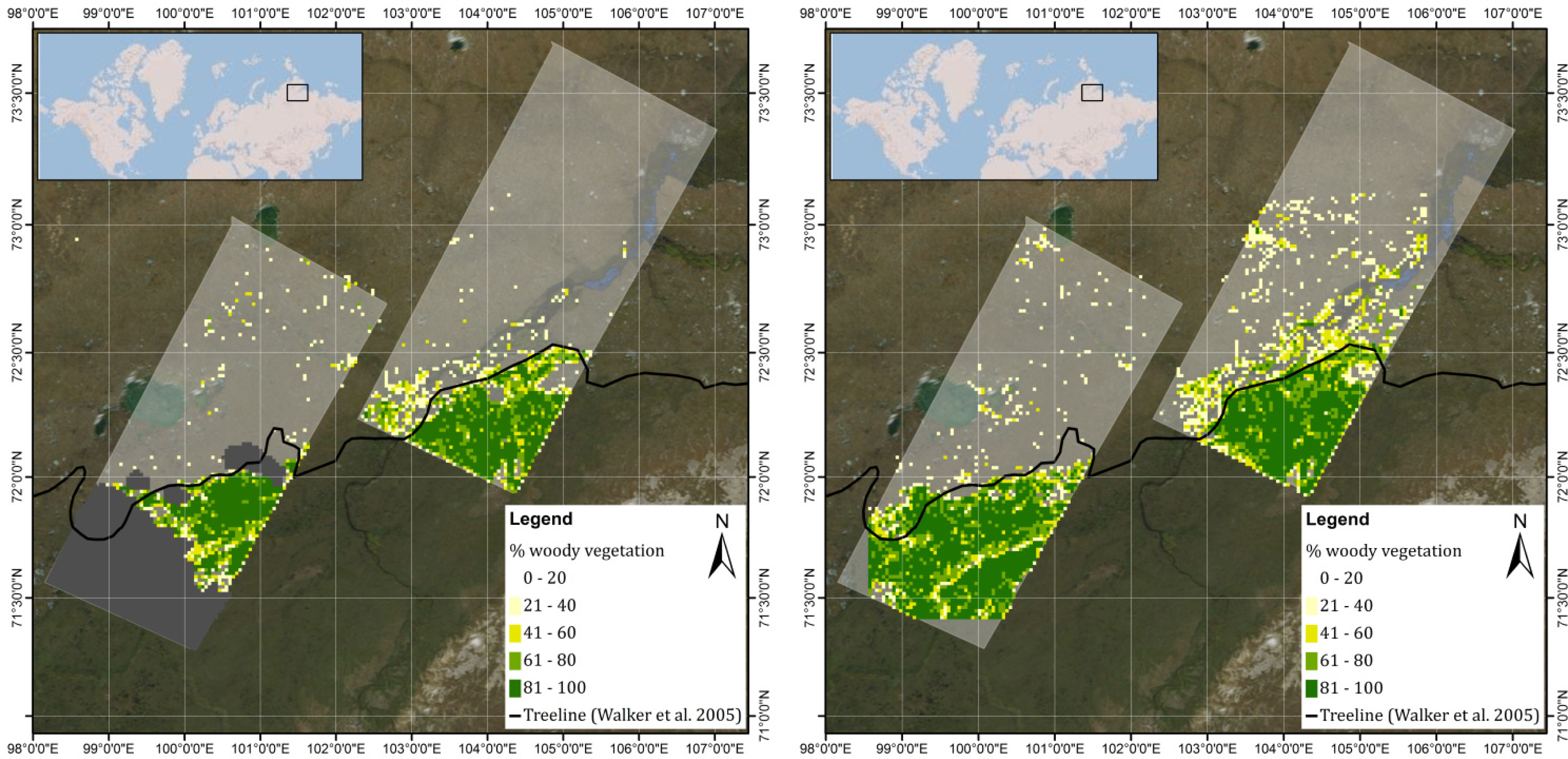
© 2014 by the authors; licensee MDPI, Basel, Switzerland This article is an open access article distributed under the terms and conditions of the Creative Commons Attribution license (http://creativecommons.org/licenses/by/3.0/).
Share and Cite
Urban, M.; Forkel, M.; Eberle, J.; Hüttich, C.; Schmullius, C.; Herold, M. Pan-Arctic Climate and Land Cover Trends Derived from Multi-Variate and Multi-Scale Analyses (1981–2012). Remote Sens. 2014, 6, 2296-2316. https://doi.org/10.3390/rs6032296
Urban M, Forkel M, Eberle J, Hüttich C, Schmullius C, Herold M. Pan-Arctic Climate and Land Cover Trends Derived from Multi-Variate and Multi-Scale Analyses (1981–2012). Remote Sensing. 2014; 6(3):2296-2316. https://doi.org/10.3390/rs6032296
Chicago/Turabian StyleUrban, Marcel, Matthias Forkel, Jonas Eberle, Christian Hüttich, Christiane Schmullius, and Martin Herold. 2014. "Pan-Arctic Climate and Land Cover Trends Derived from Multi-Variate and Multi-Scale Analyses (1981–2012)" Remote Sensing 6, no. 3: 2296-2316. https://doi.org/10.3390/rs6032296
APA StyleUrban, M., Forkel, M., Eberle, J., Hüttich, C., Schmullius, C., & Herold, M. (2014). Pan-Arctic Climate and Land Cover Trends Derived from Multi-Variate and Multi-Scale Analyses (1981–2012). Remote Sensing, 6(3), 2296-2316. https://doi.org/10.3390/rs6032296




